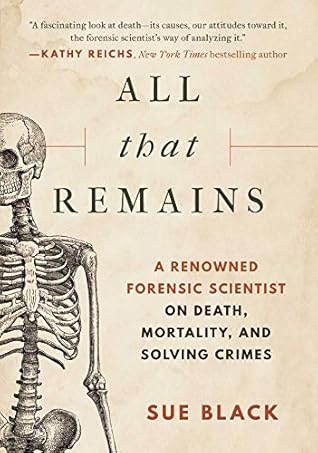More on this book
Community
Kindle Notes & Highlights
by
Sue Black
Read between
September 11 - October 24, 2023
‘Humans belong to the group of conscious beings that are carbon-based, solar system-dependent, limited in knowledge, prone to error and mortal.’
Forensic science can be used as a toolbox of techniques to reconcile an unidentified body with its previous living identity.
After forty weeks in utero, those two cells will have gone through the most miraculous transformation, becoming a highly organised mass of over 26 billion.
Remarkably, only five organs are considered vital to sustained life: the heart, brain, lungs, kidneys and liver.
Every single minute about 300 million of our cells will die, many of which are simply replaced.
The four permanent cell types are the neurons in our nervous system, a tiny
little area of bone at the base of our skull called the otic capsule, the enamel in our teeth and the lenses in our eyes.
The nutrient building blocks required to construct our otic capsule were supplied by Mum from what she was eating around sixteen weeks into her pregnancy. So within our head, in that minute piece of bone just big enough to hold four raindrops, we will perhaps carry for the rest of our lives the elemental signature of what our mother had for lunch when she was four months pregnant. Proof, if any were needed, that our mums never leave us, and a whole new perspective on the mystery of how they manage to get inside our heads.
So we could, in theory, look at the remains of an individual and, from the isotopic signatures in the otic capsule and first molar, discover where in the world their mother was living when she was pregnant with them and the nature of her diet. We could then analyse the remainder of the adult teeth to establish where the deceased person had grown up, and then the rest of their bones to determine where they had lived for the past fifteen years or so. Finally, we could use their hair and nails to locate where they spent the last years or months of their life.
In the fifth or putrefactive stage, the cells start to lose their structural integrity and their membranes begin to break down due to the slight acidity of the body fluids. This is called autolysis (literally, ‘self-destruction’) and provides the perfect conditions for anaerobic bacteria to multiply and start to consume the cells and tissues.
The planet has finite mineral resources and each of us is made up of recycled parts that we, in turn, give back to the chemical pool.
As the rate of corporeal decomposition will be influenced by climate, availability of oxygen, cause of death, burial environment, insect infestation, destruction by scavengers, rainfall and clothing, among many other factors, it is not surprising that determining the TDI can rarely be definitive.
There are three features recognised by the International Criminal Police Organisation (INTERPOL) as primary indicators of identity: DNA, fingerprints and dentition.
While fingerprints and forensic dentistry have been used in forensic science for over a hundred years, DNA analysis, the new kid on the block, has been in our forensic toolbox only since the 1980s.
That a young man chose to end his life is very sad. It is not our place to speculate about or judge what led him to commit suicide, but by giving him back his name, we allowed his story to be told.
They tease us with the possibility that we can know what death will be like; perhaps even that we can defy it. Science has alternative explanations. All of the phenomena reported can
All of the phenomena reported can occur normally if the right biochemical conditions or neurological stimuli exist to impact on brain activity. Stimulation of the temporo-parietal junction on the right side of the brain will generate a sense of floating and out-of-body levitation.
occur normally if the right biochemical conditions or neurological stimuli exist to impact on brain activity. Stimulation of the temporo-parietal junction on the right side of the brain will generate a sense of floating and out-of-body levitation. Vivid imagery, false memories and the replaying of real scenes from the past can be induced by fluctuating levels of the neurotransmitter dopamine, which interacts with the hypothalamus, amygdala and hippocampus. Depletion of oxygen and increased levels o...
This highlight has been truncated due to consecutive passage length restrictions.
‘Life is pleasant, death is peaceful. It’s the transition that’s troublesome.’


